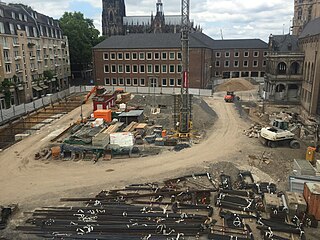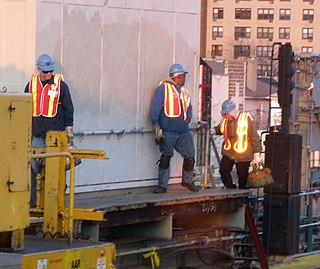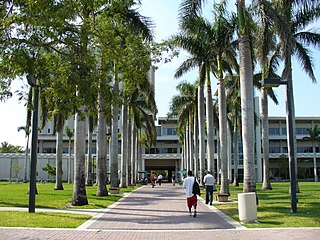
Homemaking is mainly an American and Canadian term for the management of a home, otherwise known as housework, housekeeping, housewifery or household management. It is the act of overseeing the organizational, day-to-day operations of a house or estate, and the managing of other domestic concerns. A person in charge of the homemaking, who is not employed outside the home, in the US and Canada, is called a homemaker, a term for a housewife or a househusband. Historically the role of homemaker was often assumed by women. The term "homemaker", however, may also refer to a social worker who manages a household during the incapacity of the housewife or househusband. Home health workers assume the role of homemakers when caring for elderly individuals. This includes preparing meals, giving baths, and any duties the person in need cannot perform for themselves.

An electrician is a tradesperson specializing in electrical wiring of buildings, transmission lines, stationary machines, and related equipment. Electricians may be employed in the installation of new electrical components or the maintenance and repair of existing electrical infrastructure. Electricians may also specialize in wiring ships, airplanes, and other mobile platforms, as well as data and cable lines.

Construction is a general term meaning the art and science of forming objects, systems, or organizations. It comes from the Latin word constructio and Old French construction. To 'construct' is a verb: the act of building, and the noun is construction: how something is built or the nature of its structure.

Cleaning is the process of removing unwanted substances, such as dirt, infectious agents, and other impurities, from an object or environment. Cleaning is often performed for aesthetic, hygienic, functional, safety, or environmental protection purposes. Cleaning occurs in many different contexts, and uses many different methods. Several occupations are devoted to cleaning.

A sexton is an officer of a church, congregation, or synagogue charged with the maintenance of its buildings and/or an associated graveyard. In smaller places of worship, this office is often combined with that of verger. Larger establishments, such as cathedrals, may employ a team of sextons.
Construction site safety is an aspect of construction-related activities concerned with protecting construction site workers and others from death, injury, disease or other health-related risks. Construction is an often hazardous, predominantly land-based activity where site workers may be exposed to various risks, some of which remain unrecognized. Site risks can include working at height, moving machinery and materials, power tools and electrical equipment, hazardous substances, plus the effects of excessive noise, dust and vibration. The leading causes of construction site fatalities are falls, electrocutions, crush injuries, and caught-between injuries.

A laborer is a skilled trade, a person who works in manual labor types, especially in the construction and factory industries. Laborers are in a working class of wage-earners in which their only possession of significant material value is their labor. Industries employing laborers include building things such as roads, road paving, buildings, bridges, tunnels, pipelines civil and industrial, and railway tracks. Laborers work with blasting tools, hand tools, power tools, air tools, and small heavy equipment, and act as assistants to other trades as well such as operators or cement masons. The 1st century BC engineer Vitruvius writes that a good crew of laborers is just as valuable as any other aspect of construction. Other than the addition of pneumatics, laborer practices have changed little. With the introduction of field technologies, the laborers have been quick to adapt to the use of this technology as being laborers' workforce.

A construction worker is a worker employed in the physical construction of the built environment and its infrastructure.
Process Safety Managementof Highly Hazardous Chemicals is a regulation promulgated by the U.S. Occupational Safety and Health Administration (OSHA). It defines and regulates a process safety management (PSM) program for plants using, storing, manufacturing, handling or carrying out on-site movement of hazardous materials above defined amount thresholds. Companies affected by the regulation usually build a compliant process safety management system and integrate it in their safety management system. Non-U.S. companies frequently choose on a voluntary basis to use the OSHA scheme in their business.
Housekeeping is the management and routine support activities of running and maintaining an organized physical institution occupied or used by people, like a house, ship, hospital or factory, such as cleaning, tidying/organizing, cooking, shopping, and bill payment. These tasks may be performed by members of the household, or by persons hired for the purpose. This is a more broad role than a cleaner, who is focused only on the cleaning aspect. The term is also used to refer to the money allocated for such use. By extension, it may also refer to an office or a corporation, as well as the maintenance of computer storage systems.
Justice for Janitors (JfJ) is a social movement organization that fights for the rights of janitors across the US and Canada. It was started on June 15, 1990, in response to the low wages and minimal health-care coverage that janitors received. Justice for Janitors includes more than 225,000 janitors in at least 29 cities in the United States and at least four cities in Canada. Members fight for better wages, better conditions, improved healthcare, and full-time opportunities.

Lock out, tag out or lockout–tagout (LOTO) is a safety procedure used to ensure that dangerous equipment is properly shut off and not able to be started up again prior to the completion of maintenance or repair work. It requires that hazardous energy sources be "isolated and rendered inoperative" before work is started on the equipment in question. The isolated power sources are then locked and a tag is placed on the lock identifying the worker and reason the LOTO is placed on it. The worker then holds the key for the lock, ensuring that only they can remove the lock and start the equipment. This prevents accidental startup of equipment while it is in a hazardous state or while a worker is in direct contact with it.

A roofer, roof mechanic, or roofing contractor is a tradesperson who specializes in roof construction. Roofers replace, repair, and install the roofs of buildings, using a variety of materials, including shingles, bitumen, and metal. Roofing work includes the hoisting, storage, application, and removal of roofing materials and equipment, including related insulation, sheet metal, vapor barrier work, and green technologies rooftop jobs such as vegetative roofs, rainwater harvesting systems, and photovoltaic products, such as solar shingles and solar tiles.

Window cleaning, or window washing, is the exterior cleaning of architectural glass used for structural, lighting, or decorative purposes. It can be done manually, using a variety of tools for cleaning and access. Technology is also employed and increasingly, automation.

A cleaner or a cleaning operative is a type of industrial or domestic worker who does the cleaning.
Manufacturing in Mexico grew rapidly in the late 1960s with the end of the US farm labor agreement known as the bracero program. This sent many unskilled farm laborers back into the Northern border region with no source of income. As a result, the US and Mexican governments agreed to The Border Industrialization Program, which permitted US companies to assemble product in Mexico using raw materials and components from the US with reduced duties. The Border Industrialization Program became known popularly as The Maquiladora Program or shortened to The Maquila Program.
Crime scene cleanup is a term applied to cleanup of blood, bodily fluids, and other potentially infectious materials (OPIM). It is also referred to as biohazard remediation, and forensic cleanup, because crime scenes are only a portion of the situations in which biohazard cleaning is needed. Incidents which may require this type of cleanup include accidents, suicide, homicides, and decomposition after unattended death, as well as mass trauma, industrial accidents, infectious disease contamination, animal biohazard contamination or regulated waste transport, treatment, and disposal.

Fall protection is the use of controls designed to protect personnel from falling or in the event they do fall, to stop them without causing severe injury. Typically, fall protection is implemented when working at height, but may be relevant when working near any edge, such as near a pit or hole, or performing work on a steep surface. Many of these incidents are preventable when proper precautions are taken, making fall protection training not only critical, but also required for all construction workers. Fall Protection for Construction identifies common hazards and explains important safety practices to help ensure every team member is prepared to recognize fall hazards on the job and understand how to keep themselves and others safe.
Commercial cleaning companies are contracted to carry out cleaning jobs in a variety of premises.Commercial cleaners, often referred to as custodians or janitors, work in a many different types for building such as schools, banks, offices, etc. As a janitor or custodian, the main job duty is to disinfect/ pick up in the fast-paced environments that come with working in commercial buildings.

The University of Miami Justice for Janitors campaign was a nine-week strike by custodial workers at the University of Miami in Coral Gables, Florida, which lasted from February 28, 2006 to May 3, 2006.













